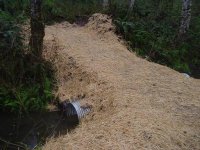CurlyDave
Elite Member
I need to put in a 20' culvert to extend a road to an RV pad I am building. I need to be able to drive both a 14,000 # motorhome and my 8000 # tractor over the culvert, not at the same time.
I have seen both metal and plastic used, the costs are close in my area.
Which is the preferred type & why?
Second question:
How do I tell what size to use? The county says 12" minimum everywhere, but for the difference in cost I would rather do it right (maybe some overkill) the first time than replace it next year if it is too small.
From the topo map, it looks like the water from 10-20 acres of 15%+ slope drains through this spot. The culvert will have about a 10% slope.
I am sort of leaning to 24" diameter, which only costs twice as much as 12".
The culvert is going into a natural gully and not a ditch. I looks to me like there will be over 3' of fill over the culvert at one end, and over 5' at the other.
Third Question:
Do I need to fill around the culvert with gravel or can I just use the dirt I excavated for the RV pad?
Forth Question:
Should I have some kind of grate to prevent debris from entering the culvert?
I have seen both metal and plastic used, the costs are close in my area.
Which is the preferred type & why?
Second question:
How do I tell what size to use? The county says 12" minimum everywhere, but for the difference in cost I would rather do it right (maybe some overkill) the first time than replace it next year if it is too small.
From the topo map, it looks like the water from 10-20 acres of 15%+ slope drains through this spot. The culvert will have about a 10% slope.
I am sort of leaning to 24" diameter, which only costs twice as much as 12".
The culvert is going into a natural gully and not a ditch. I looks to me like there will be over 3' of fill over the culvert at one end, and over 5' at the other.
Third Question:
Do I need to fill around the culvert with gravel or can I just use the dirt I excavated for the RV pad?
Forth Question:
Should I have some kind of grate to prevent debris from entering the culvert?
